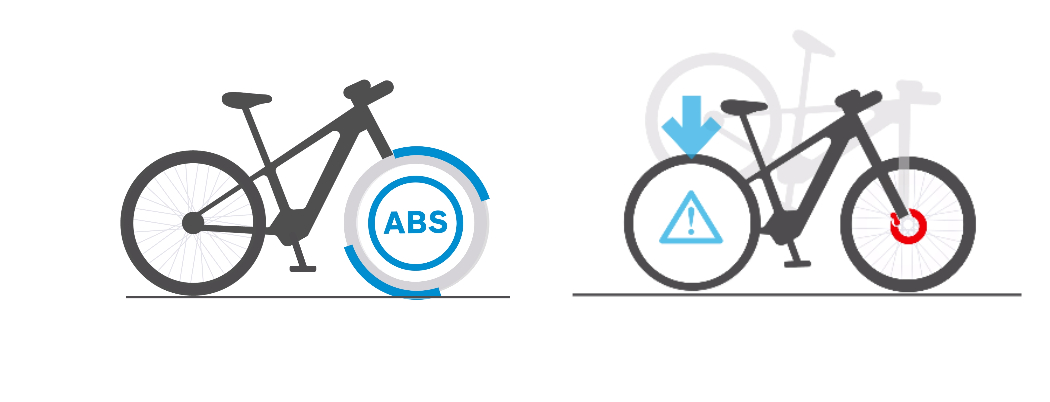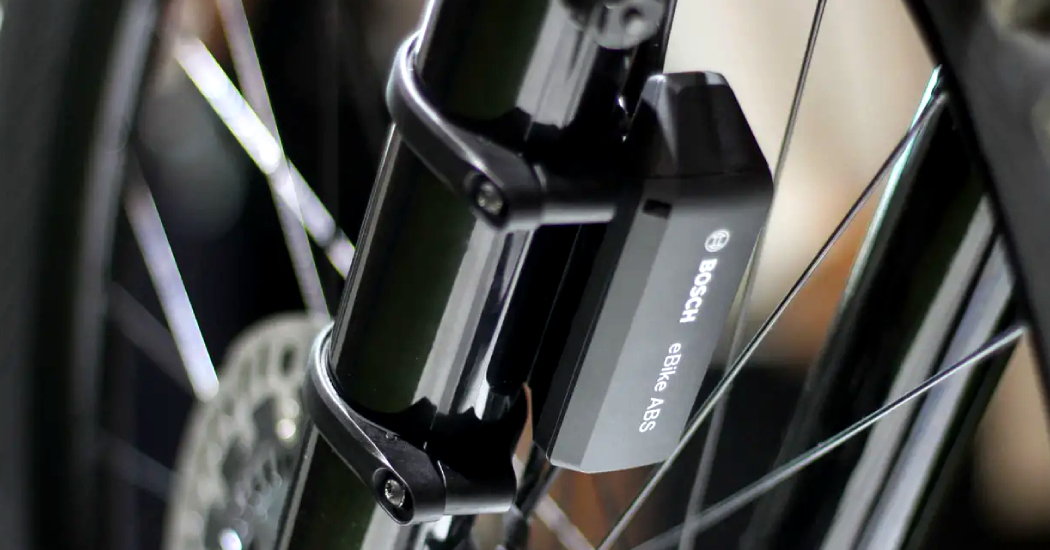Quick search
The transfer of technologies and innovations from the automotive sector to new bicycles has already been seen with the revamped cargo boxes of popular cargo bikes. Safety comes first, especially when transporting children. Also, for speed pedelecs, where you ride alone, at high speeds, this ABS technology for electric bikes is a godsend.
A brand-new technology from Bosch and now also Shimano, or rather Blubrake. Soon, other brands will also integrate this technology. It’s not mandatory, but it does offer more safety during braking. In this article, we explain what ABS technology is and how it makes a difference on the bike. We also tested it, and you’ll find our findings throughout the article.
What is ABS
ABS stands for Anti-lock Braking System. This system prevents the wheels of a vehicle from locking up during braking. It’s a safety feature that has been developed long ago for cars and is now also available for electric bikes and speed pedelecs.
Now also for the electric bike and speed pedelec
One of the main reasons why ABS brakes are important for electric bikes is that these bikes often reach higher speeds than traditional bikes. Especially for speed pedelecs, this is interesting.
Higher speed means longer braking distance and a greater chance of an accident (or loss of control). If you brake too hard with your front or rear wheel, you can start sliding. If you squeeze the front brake too hard, the rear wheel may lift off the ground.
ABS brakes help reduce this risk by ensuring that the wheels do not lock up during braking and the cyclist maintains more control over the bike. Speed pedelecs, which can reach speeds of up to 45 km/h, benefit even more from ABS brakes.
It works efficiently and safely
So, how does ABS work with electric bikes? ABS brakes for electric bikes consist of a small, lightweight, and improved version of traditional ABS hardware. The system acts as a kind of regulator for the hydraulic brake fluid used in the brakes.
A sensor on the rear wheel measures the bike’s speed, and if there is a difference in speed between the front and rear wheels, the system adjusts the hydraulic pressure to ensure that the wheels do not lock up.
ABS brakes are designed to prevent the wheels of a vehicle from locking up during braking. This is achieved by regulating the brake pressure applied to each wheel. The basic principles of ABS braking are:
- A speed sensor measures the speed of each wheel.
- A control module compares the speed of the wheels and detects when a wheel is at risk of locking up.
- A hydraulic valve regulates the brake pressure on the wheel to prevent locking and ensure optimal braking performance.
In electric bikes, the ABS system has been adapted to be smaller and lighter than in cars, but the basic principle remains the same.
Anti-skid and anti-lift technologies
Anti-skid (anti-slip or slide) and anti-lift (anti-lift) are additional features of ABS brakes that further improve the braking performance and safety of the cyclist.
Anti-skid
This technology prevents the front wheel from slipping or skidding during braking. When the ABS control module detects that the front wheel is at risk of locking up, it reduces the brake pressure on that wheel, allowing it to keep turning and the cyclist to maintain more control. This is especially important on wet or slippery surfaces, where the risk of slipping is greater.
Anti-lift
This feature prevents the rear wheel from losing contact with the ground and lifting up during heavy braking, which can lead to an uncontrolled situation. When the ABS control module detects that the rear wheel is at risk of lifting off the ground, it reduces the brake pressure on the front wheel, keeping the rear wheel on the ground and the cyclist stable.

The benefits of ABS brakes
The benefits of ABS brakes for electric bikes are numerous. The main advantage is that they improve the safety of the cyclist by reducing the chance of accidents. Additionally, they also offer a better braking experience and more control over the bike.
ABS brakes are also tailored to specific users, such as touring cyclists, trail riders, and even cargo bikes. During our tests, we noticed that ABS technology ensures the bike remains stable during braking, even on wet or uneven surfaces (source: Autoweek).
The drawbacks of ABS brakes
Although the benefits of ABS brakes are clear, there are also some drawbacks. Firstly, ABS brakes can increase the purchase price of an electric bike. Additionally, the brakes may be heavier than traditional brakes, resulting in a slightly higher overall weight of the bike. However, we believe that these drawbacks are outweighed by the benefits in terms of safety and control.
Biking with or without ABS (tested)
The main difference between a bike with ABS brakes and one without is the braking performance and the safety of the cyclist.
Safety
Bikes with ABS brakes offer a higher level of safety by reducing the chance of accidents caused by locked wheels. Cyclists with ABS brakes retain more control over their bikes during braking, allowing them to better respond to unexpected situations.
Braking Performance
ABS brakes provide a smoother and more controlled braking experience. This is especially noticeable on wet or slippery surfaces, where traditional brakes may be less effective. Bikes without ABS may suddenly lock up during braking, leading to a loss of control and possibly a fall.
Stability
Thanks to the anti-lift technology, the rear wheel of a bike with ABS stays better in contact with the ground during hard braking, providing more stability. This is a significant advantage compared to bikes without ABS, where the rear wheel may lose contact with the ground during hard braking, causing the cyclist to lose balance.
Control
With ABS brakes, the cyclist maintains better control over the bike, especially on challenging surfaces and at higher speeds, such as with speed pedelecs. Bikes without ABS may be more difficult to control in such situations, leading to unsafe conditions.

Frequently Asked Questions
Are ABS brakes mandatory?
At this moment (May 2023), ABS brakes are not mandatory for electric bikes or speed pedelecs. However, given the numerous benefits of this technology, it wouldn’t surprise us if this changes in the future. For speed pedelecs, making ABS brakes mandatory would certainly make sense.
Currently, there aren’t many brands that offer it as a standard feature. It increases the cost and is not a necessity; you can still ride safely without ABS. In our search for the right speed pedelec, you’ll notice that only one or two models already have this feature.
Which brands offer ABS?
Bosch was the first to start with this. Naturally, Shimano follows; it was a logical development, necessary to make speed pedelecs and electric bikes safer.
Can I install ABS brakes on my electric bike?
It is technically possible to retrofit ABS brakes onto an electric bike, but most bicycle mechanics are not trained for this. It’s not an easy process, and it’s important that it’s done correctly to ensure safety. If you want ABS brakes, we recommend purchasing an electric bike already equipped with this technology.
Do they work at low speeds and on wet surfaces?
Yes, ABS brakes work at all speeds and on various surfaces. They are particularly effective on wet or slippery surfaces, where traditional brakes may be less effective. During our tests, we found that the ABS technology kept the bike stable during braking, even on wet or uneven surfaces.


1 comment
[…] just wrote an article about ABS brakes. Unfortunately, we don’t see them here yet. Perhaps in the Multitinker […]